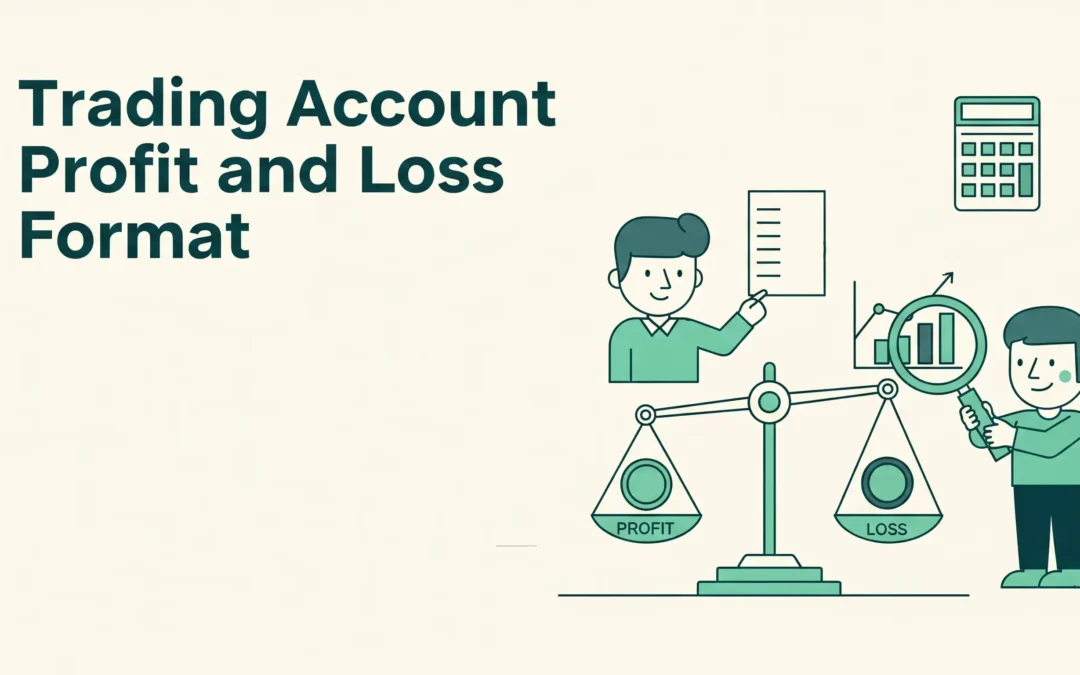A business needs to prepare various accounts to document its revenue and expenses. It is not an option but is mandatory as many people are interested in knowing the performance of company or business like the shareholders, governments, etc. Trading and profit and loss account is one such account that separates the direct and indirect expense of the business.
The article will help you understand the meaning of this account, along with the predefined format that is used to prepare it. Also, it will give insights into points that you must remember while preparing the final accounts.
Understanding Trading and Profit & Loss Account
One component of final accounts that shows a company’s financial performance over an accounting period is the Trading and Profit & Loss Account. To ascertain the amount of profit (or loss) the company made, it is typically prepared at the end of the fiscal year.
There are two primary sections to the account:
- The purpose of a trading account is to calculate the gross profit or loss from core operations.
- The purpose of the profit and loss account is to calculate net profit or loss after indirect income and expenses are taken into account.
Key Features:
- Demonstrates performance: Aids in monitoring company profitability over a given time frame.
- Two-part structure: Separates profit and loss accounts, which account for indirect expenses from the trading account, which accounts for direct expenses.
- Beneficial to stakeholders: Aids in financial analysis for owners, creditors, and investors.
- Basis for tax filing: Establishes a company’s taxable income.
Standard Format of Trading and Profit & Loss Account
Here is a clear format that illustrates how figures are arranged under their respective heads to help you understand how it works.
Example of Trading Account:
| Particulars (Dr) | Amount (Rs. ) | Particulars (Cr) | Amount (Rs. ) |
| To Opening Stock | 50,000 | By Sales | 3,00,000 |
| To Purchases | 1,50,000 | By Closing Stock | 70,000 |
| To Direct Expenses (e.g., wages) | 30,000 | ||
| To Gross Profit c/d (balancing fig) | 1,40,000 | ||
| Total | 3,70,000 | Total | 3,70,000 |
- The results of direct trading activities are displayed in the Trading Account.
- These expenses are directly related to the day-to-day operations of the business.
Example of Profit and Loss Account:
| Particulars (Dr) | Amount (Rs. ) | Particulars (Cr) | Amount (Rs. ) |
| To Salaries | 40,000 | By Gross Profit b/d | 1,40,000 |
| To Rent, Electricity | 20,000 | By Commission Received | 10,000 |
| To Depreciation | 15,000 | ||
| To Net Profit transferred to Capital A/c | 75,000 | ||
| Total | 1,50,000 | Total | 1,50,000 |
List of items in Trading and P&L account:
| Direct Items (Trading Account): | Indirect Items (P&L Account): |
| Opening Stock | Rent, Electricity, Office Salaries |
| Purchases | Commission Received |
| Wages & Carriage Inward | Depreciation |
| Sales | Advertisement Expenses |
| Closing Stock |
Suggestions: Important Points to Remember While Preparing
Let us now look at some of the important points to consider while preparing these accounts:
1. Sort Expenses Correctly
- Always separate direct and indirect expenses to avoid errors in your accounts.
- Direct expenses like the purchase of goods and wages for production staff go to the Trading Account.
- The Profit & Loss Account is responsible for indirect costs, such as rent, salaries, and depreciation.
2. Adhere to the Matching Principle
- The matching principle means recording expenses with the related revenues in the same period, not just balancing debit and credit.
- This provides an accurate representation of profit or loss.
3. Employ Accrual Accounting
- Instead of recording income and expenses when money is received or paid, do so as soon as they are incurred.
- This keeps profits from being overstated or understated.
- This concept is also known as accrual accounting.
4. Verify Adjustments a Second Time
- Closing Stock: Verify that it is shown as an asset on the balance sheet and on the credit side of the trading account.
- Prepaid expenses: It should be displayed as a current asset and deducted from the total expense in the P&L.
- Accrued Income: Show it when the income is generated and not when the cash is received.
- Depreciation: Appropriately apply it to the asset and include it in the P&L as an expense.
- Bad Debts and Provisions: Verify that any provisions or write-offs for questionable debts have been updated.
5. Consistency is the key
- To make comparisons between years simple, use the same format and accounting procedures every year.
- It will make the comparison easy and more reliable.
Bottomline
The conclusion can be drawn that trading and profit and loss account an important accounting concepts. It separates the direct and indirect expenses and gives a clear picture of business operations. In case the business owner wants to reduce expenses, this account will help identify the area where the cost can be lowered. Following the preparation of the final account every year eases the process of comparison and helps in identifying the performance of the business when compared to previous years.
The format above, along with the list of items, will help in making the final account even for beginners.


